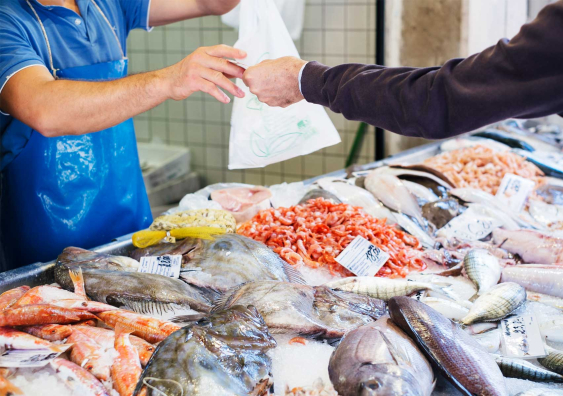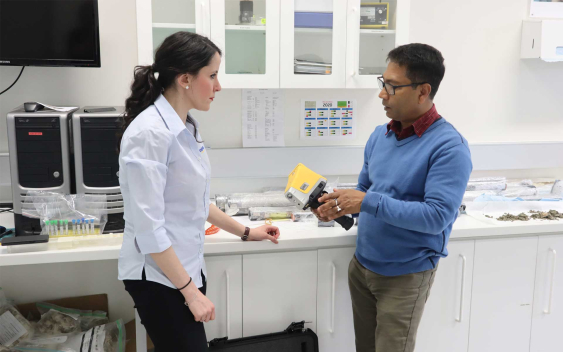At the foreshore of sustainable fishing: a new tool to tackle seafood fraud
A handheld scanner uses nuclear methods and mathematical models to determine the origin and production of seafood.ŐżŐż
A handheld scanner uses nuclear methods and mathematical models to determine the origin and production of seafood.ŐżŐż

Lilly Matson
UNSW Science
0426 656 007
l.matson@unsw.edu.au
Warming waters due to climate change, pollution, overfishing and fraud in the seafood supply chain means that knowing where your seafood comes from, and that it has been sourced sustainably and without forced labor, is as important as ever.ŐżŐż
While Australia has the third-largest fishing zone in the world, covering more than , it is estimated that  of seafood consumed in Australia is imported.
Researchers at UNSW Sydney are part of an ongoing collaborative project¬†led by Australia's Nuclear Science and Technology Organisation¬†() to develop new ways to determine where seafood has been sourced, and whether it has been farmed or wild-caught.ŐżŐż
‚ÄúThe seafood supply chain, especially with seafood imported from across the globe, is quite long. And there are various people at different points in the supply chain that handle a seafood product,‚ÄĚ says Associate Professor Jes Sammut¬†from the School of BEES. ‚ÄúAnd in that process, there is the risk of what we call ‚Äėfood fraud‚Äô.‚Ä̬†
Mislabelling is a common type of food fraud. ‚ÄúFor example, a product may say that it‚Äôs a barramundi fillet from Australia, when it‚Äôs really a barramundi fillet from overseas. Mislabelling can also happen at the retail end, so a cheaper product can be labelled as more expensive based on its origin and production method,‚ÄĚ says A/Prof. Sammut.ŐżŐż
Looking for solutions to these ongoing challenges, ANSTO scientists,¬†led by , and a research team at UNSW have developed protocols and mathematical models for a handheld device that can determine the origin of seafood by providing a unique profile of its elements.ŐżŐż
‚ÄúThe idea is to use the handheld device at any point in the supply chain, providing details that can lead to a more sustainable and ethical seafood trade,‚ÄĚ says A/Prof. Sammut.¬†
This ongoing research is part of a collaborative effort between ANSTO, UNSW, , and the .ŐżŐż
‚ÄúWe have had a very productive research partnership with ANSTO. Working with the project lead, Dr Mazumder, the wider team at ANSTO and our partner agencies has created opportunities to translate this research into impactful outcomes,‚ÄĚ says A/Prof. Sammut.ŐżŐż
‚ÄúThis device is really about empowering the consumer, empowering the retailer and also empowering the wholesalers to know more about the produce they‚Äôre buying and selling.‚Ä̬†
As well as food fraud, escalating environmental and human rights threats and financial challenges in the food industry mean¬†that being able to determine the origin of food ‚Äď also known as food provenance ‚Äď is becoming increasingly important.ŐżŐż
‚ÄúHistorically, people used DNA to help confirm what species a fish is,‚ÄĚ says A/Prof. Sammut. ‚ÄúBut it doesn't tell you where it came from or whether it was farmed or wild.‚Ä̬†¬†
As A/Prof. Sammut explains,¬†scientists have used high-end equipment¬†‚Ästsuch as X-ray fluorescence¬†and isotope ratio mass spectrometry¬†‚Ästto determine food provenance in the lab¬†by studying the elemental profile¬†of seafood. ‚ÄúFor example, by measuring the abundance of different metals and determining the different ratios of in a sample, we can create a unique chemical fingerprint.‚Ä̬†¬†
Importantly, the elements and isotopes found within any individual organism are specific to each organism and determined by factors including diet, climate and environmental conditions.ŐżŐż
By measuring these elements and isotopes, scientists can record a unique ‚Äúfingerprint‚ÄĚ that varies by geographical location or production method.¬†
While elemental profiling has emerged as a useful tool for authenticating provenance, its adoption by the food industry has been slow, as most of the equipment remains lab-based.   
Dr Mazumder, who is also an adjunct Professor in UNSW‚Äôs Centre for Ecosystem Science, worked previously with A/Prof. Jes Sammut on improving fish feeds in aquaculture. ‚ÄúThis unique university and industry collaboration extended to the seafood provenance research. Initially, the research team used a range of nuclear analysis techniques to determine seafood provenance,‚ÄĚ says Dr Mazumder. ‚ÄúThe outcome of this work helped the team theorise that a portable device could be used to determine the provenance of the seafood we eat.‚Ä̬†
The team repurposed handheld elemental scanners (such as the Olympus Vanta device), typically used to scan sediment samples, to scan biological tissue to obtain the elemental fingerprints of various seafood products.   
‚ÄúSo while the instrument itself isn't new, the repurposing of it for seafood is, as well as all the work testing and developing the protocols,‚ÄĚ says A/Prof. Sammut.ŐżŐż

Dr Debashish Mazumder holds the Olympus FXS handheld scanner, provided by Olympus. Photo: ANSTO.
Over the last five years, the team has produced a number of papers testing the proof-of-concept of the lab-based itrax and the handheld scanning device for the provenance of a variety of seafood.ŐżŐż
In a recent study published in ,¬†the multidisciplinary team used the handheld X-ray device to locate the site of origin of black tiger prawns from across Australia, with over 80 per cent accuracy.ŐżŐż
‚ÄúThis paper brings us a step closer to seeing the scanner device being used on the fish-market floor, to determine in real time, where seafood has come from, and how it was produced,‚ÄĚ says A/Prof. Sammut.¬†
While the seafood industry in Australia has an international reputation as a trusted supplier, the long and opaque supply chains in the global industry make it particularly vulnerable to food fraud. 
Last year the Australian government promised $1.6 million to deliver on its commitment to introduce in the seafood industry. The government hopes to work closely with the seafood and hospitality sectors to improve seafood labelling and help consumers make informed decisions about the food they buy.ŐżŐż
But until now, there has not been a single method that can easily determine food origin and be used to combat seafood fraud. 
‚ÄúWe hope this tool will help advance the country-of-origin labelling, and if that means your local fish and chip shop will need to state the geographical origin of a product, including whether it was farmed or wild. So again, this tool is a way of ensuring this compliance,‚ÄĚ says A/Prof Sammut.ŐżŐż
‚ÄúTechnological innovations such as this scanner will play an important role in the prevention of food fraud in years to come,‚ÄĚ says Erik Poole, Innovation and Technical Manager at Sydney Fish Market. ‚ÄúMost importantly, by demystifying the supply chain and providing consumers with trustworthy information about seafood provenance, we hope that research like this equips Australians with the tools to confidently choose Australian seafood, whenever possible.‚Ä̬†
Food fraud isn’t the only thing the handheld device can help combat. Knowing where a product has come from can also help identify seafood that may have been produced by forced labour, as well as determining locations for biosecurity breaches. The elemental profile of seafood can also assist with determining whether a product reaches food safety standards. 

Patricia Gadd, part of the collaborative team, handles an organic sample using the full-sized itrax scanner in the lab. Photo: ANSTO.
While the use of the handheld scanner has huge implications across the seafood supply chain, there are steps that need to be taken before we can expect to see it in regular use.ŐżŐż
"We need the industry to tell us which products they‚Äôre most concerned about,‚ÄĚ says Dr Mazumder. "We know the source of prawns and barramundi are issues, but what else?‚Ä̬†
This is where the partnership with Sydney Fish Market is so essential. ‚ÄúWe need to get samples across Australia and overseas, to get the information into our database, so that when you analyse seafood using the handheld scanner, it can tell you with more precision where the product has come from,‚ÄĚ says A/Prof. Jes Sammut.¬†
The provenance technology has been developed¬†over a number of years with the help of research. ‚ÄúAt the moment, we can comfortably say whether a tiger prawn is wild-caught or farmed, and we are now at a point where there is an opportunity for expansion,‚ÄĚ says¬†Dr Mazumder.¬†
This research also involved Patricia Gadd, Dr Jasmin Martino, Dr Karthik Gopi, Dr Jagoda Crawford, Dr Carol Tadros, Prof Neil Saintilan and Nondita Malo from across the ANSTO and UNSW Sydney partnership.